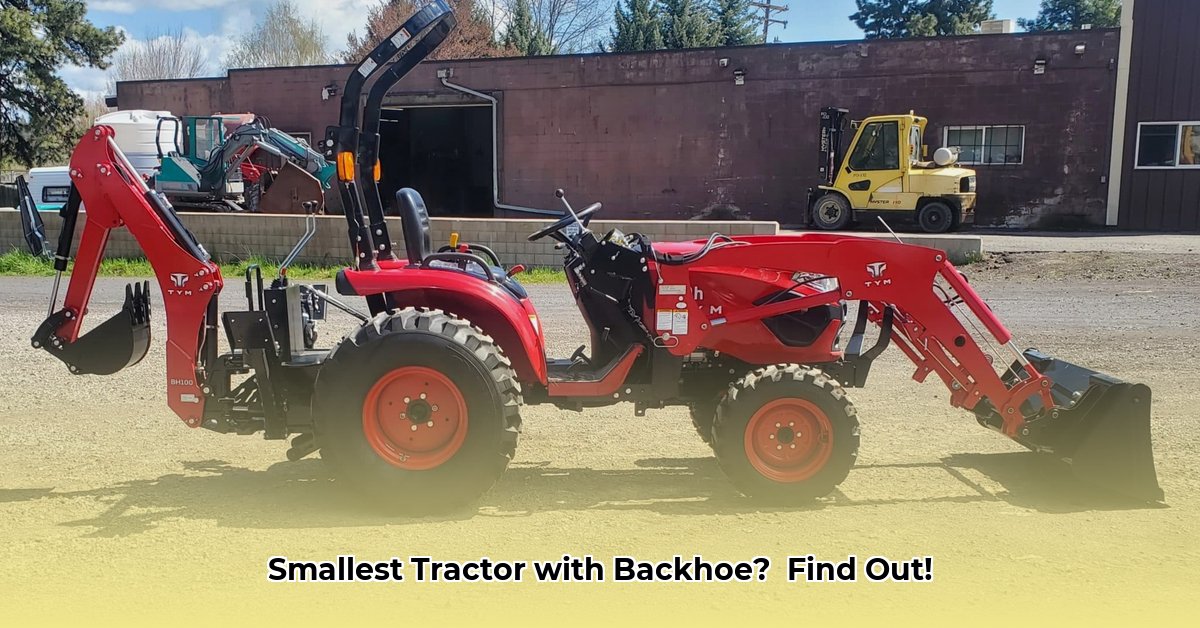
Finding the right compact tractor with a backhoe is crucial for sustainable small farms. This guide helps you navigate the options, focusing on features that maximize efficiency, minimize environmental impact, and fit your budget. We'll compare popular models and offer actionable recommendations for selecting the best tractor for your specific needs. For more detailed information on backhoes, check out this helpful guide.
Assessing Your Needs: The Right Tractor for Your Farm
Before diving into models, honestly assess your farm’s requirements. This ensures you choose a tractor that's both effective and sustainable.
- Acreage: Larger farms may require more powerful tractors, while smaller plots benefit from maneuverable compact models.
- Soil Type: Heavy clay requires more horsepower than sandy loam. This impacts the tractor's digging and tilling capabilities.
- Primary Tasks: Define your main applications for the backhoe and tractor – simple earth moving, fence post installation, or more extensive tasks. This dictates the necessary horsepower and features.
- Budget: Consider not only the initial purchase price but also the long-term costs of fuel, maintenance, and repairs.
Choosing the right size is crucial. Oversized tractors lead to unnecessary fuel consumption and difficulty maneuvering in confined spaces. Finding the right balance of power and size is key to sustainable farming.
Key Features: Criteria for Sustainable Tractor Selection
Several compact tractors offer backhoe attachments, expanding their versatility. However, not all models are equally sustainable. Prioritize these features:
- Horsepower (HP): Indicates the tractor's power – higher HP handles heavier tasks but increases fuel consumption. Find the optimal balance for your needs.
- Fuel Efficiency: Measured by fuel consumption per unit area (e.g., gallons/acre), this directly impacts your operating costs and environmental footprint. Lower is better.
- Lift Capacity: The maximum weight the tractor's hydraulic system can lift – essential for backhoe operations. Consider the heaviest loads you'll handle.
- Price: Assess the initial cost and long-term expenses, including maintenance and potential repairs.
- Warranty: A comprehensive warranty safeguards your investment against unexpected repairs.
- Emissions: Look for tractors with lower emissions to reduce your farm's environmental impact. Check for EPA or equivalent certifications.
- Maintenance & Repairability: Easy maintenance and readily available parts minimize downtime and extend the tractor's lifespan, reducing waste. A simpler design often means easier, cheaper repairs.
Comparative Analysis: Popular Compact Tractor Models
The following table presents a comparison. Note: Specifications can vary by model and year. Always check with manufacturers for precise data.
| Tractor Model | Horsepower | Fuel Efficiency (est.) | Lift Capacity (lbs) | Approximate Price (USD) | Warranty (yrs) | Emissions (est.) | Maintenance | Repairability |
|---|---|---|---|---|---|---|---|---|
| John Deere 1025R | 25 | Varies | Varies | Varies | Varies | Varies | Good | Good |
| Kubota B26 TLB | 26 | Varies | Varies | Varies | Varies | Varies | Good | Good |
| Yanmar SA221 | 22 | Varies | Varies | Varies | Varies | Varies | Good | Good |
| New Holland Workmaster 25S | 25 | Varies | Varies | Varies | Varies | Varies | Good | Good |
| Kubota L2501 | 25 | Varies | Varies | Varies | Varies | Varies | Good | Good |
| Massey Ferguson GC1725M | 25 | Varies | Varies | Varies | Varies | Varies | Good | Good |
| Kioti CS2520 | 25 | Varies | Varies | Varies | Varies | Varies | Good | Good |
| Kioti CS2610 | 26 | Varies | Varies | Varies | Varies | Varies | Good | Good |
Sustainability: A Holistic Approach
Sustainable farming encompasses more than fuel efficiency. Consider the entire tractor lifecycle:
- Manufacturing: Support manufacturers committed to responsible sourcing and reduced environmental impact during production.
- Usage: Regular maintenance extends the tractor's life, reducing the need for frequent replacements.
- Disposal: Plan for responsible disposal or recycling at the end of the tractor's lifespan. Investigate options for responsible end-of-life management within your region.
Choosing Your Tractor: Actionable Recommendations
Selecting the right tractor involves balancing your farm's needs, your budget, and your commitment to sustainability. Thoroughly research each model, compare features, and factor in long-term costs. Don't hesitate to consult with experienced farmers or equipment dealers for personalized guidance.
Further Considerations: Beyond the Basics
- Operator Comfort: Consider the ergonomics and overall comfort of the tractor's cab for long hours of operation.
- Dealer Support: Choose a tractor with a strong local dealer network for ease of maintenance and parts availability. A responsive dealer is invaluable.
- Financing Options: Investigate available financing options to spread out the high initial cost of the tractor.
By carefully considering these factors, you can choose a compact tractor that truly supports your sustainable farming goals.